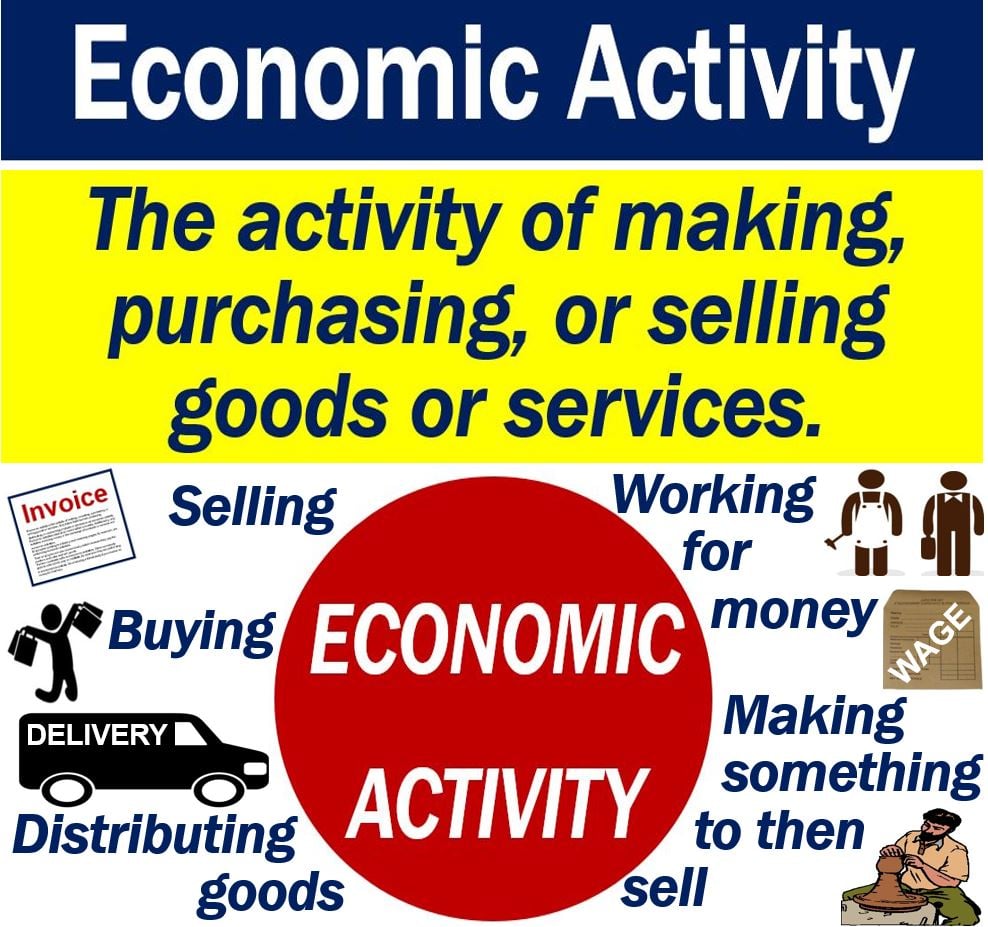What is economic activity? Definition and examples
Economic Activity is the activity of making, providing, purchasing, or selling goods or services. Any action that involves producing, distributing, or consuming products or services is an economic activity.
Economic activities exist at all levels within a society. Additionally, any activities involving money or the exchange of products or services are economic activities. For instance, running a small business is a great example of economic activity and one you can learn more about at MultipleStreams.org.
The advent of the digital economy has expanded the scope of economic activities, allowing for the creation and exchange of goods and services through virtual platforms.
Employees working in a factory and receiving wages, for example, are performing economic activities. Their employers are also economically active because they pay the workers and make and sell goods.
The term contrasts with non-economic activities. When somebody goes to a temple to pray or meditate, for example, they are performing a non-economic activity. So is helping a friend study if you receive no money for that help.

Economic activity – two definitions
There are many ways to define the term.
The University of Toronto’s Department of Economics has the following definition:
“Economic activity is the process by which the stock of resources or stock of capital produces a flow of output of goods and services that people utilize in partial satisfaction of their unlimited wants.”
“This process involves not only the production of goods and services but their distribution among the various members of the community.”
If Toronto University’s explanation is too complicated, perhaps you’d prefer Cambridge Dictionary’s simpler definition:
“The activity of producing, buying, or selling products or services.”
Economic activity – main aim
One of the main aims of economic activity is to produce goods and services to make them available to consumers.
All activities which we perform in exchange for money or things of value are economic activities.
Put simply; economic activities are those which we undertake to earn income, money, or wealth.
Unlimited wants vs. scarcity
With these activities, we secure the greatest satisfaction of unlimited wants with scarce and limited means.
‘Unlimited wants’ is an economic term. It refers to human’s insatiable appetite for things. Humans never get enough because there is always something else that we want or need.
However, even though we have unlimited wants, the resources we have available to get them is limited. In other words, the things we want are scarce.
Scarcity, which has plagued us ever since we first set foot on this Earth, has two halves:
- Limited resources.
- Unlimited wants.
GDP
GDP is the sum of every economic activity in a country. GDP stands for gross domestic product.
It is the most important economic measure of the state of a country’s economy. With one simple figure, we can tell whether an economy has grown, shrunk, or remained the same since one year ago.
In other words, GDP tells us whether economic activity has increased, declined, or remained flat.
Economic activity – classifications
Economists say there are four basic types of economic activities:
- Primary Sector – involves extracting and harvesting natural resources, such as agriculture, mining, and forestry.
- Secondary Sector – encompasses the processing of raw materials from the primary sector into goods, like manufacturing and construction.
- Tertiary Sector – provides services to consumers and businesses, such as retail, entertainment, and financial services.
- Quaternary Sector – focused on knowledge-based activities involving services like information technology, research, and education.
Modern economic activity increasingly incorporates sustainable practices, aiming to balance profitability with environmental responsibility and social equity.
Compound nouns
There are many compound nouns, i.e., terms consisting of two or more words, containing the words “economic activity.” Let’s have a look at some of them, their meanings, and how we can use them in a sentence:
-
Economic Activity Indicator
A statistic that shows current economic growth and stability.
Example: “The rise in employment levels is a positive economic activity indicator signaling recovery.”
-
Economic Activities Analysis
The study or examination of the production, distribution, and consumption of goods and services.
Example: “Economic activities analysis can reveal the underlying health of a market.”
-
Economic Activity Zone
A designated area where business and trade laws are different from the rest of the country to increase economic activity.
Example: “The government established an economic activity zone to attract foreign investment.”
-
Economic Activity Regulation
Laws or rules governing the conduct of business operations.
Example: “New economic activity regulation may impact the way companies report earnings.”
-
Economic Activity Trend
The general direction in which economic activities are moving over time.
Example: “Analysts are concerned about the downward economic activity trend due to the trade war.”
-
Economic Activity Cycle
The natural fluctuation of the economy between periods of expansion and contraction.
Example: “The economic activity cycle affects all sectors, from construction to consumer goods.”
-
Economic Activities Sector
A segment of the economy, like agriculture or services, in which economic activities occur.
Example: “The technological boom has significantly boosted the economic activities sector related to IT services.”
Video – What is Economic Activity
This interesting video presentation, from our YouTube partner channel – Marketing Business Network, explains what a ‘Economic Activity’ is using simple and easy-to-understand language and examples.

